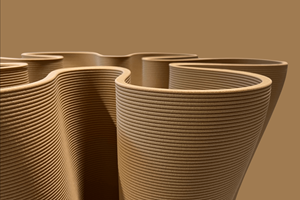Smart carbon nanotubes for wind turbine blade anti-icing system
Fraunhofer Institute for Manufacturing researches develop energy-efficient method to free turbine blades from ice in seconds.
As reported in by nanowerk.com, wind turbines have rarely been built in very cold climate zones because the risk of ice formation on the rotor blades is too high for economical operation. Even though the wind often blows with great force, aerodynamic properties deteriorate when an ice layer forms on the rotor blades as temperatures drop below zero, reducing energy production and putting the turbine at risk for breakdown. Icicles breaking off are also a safety risk.
But now, an energy-efficient heating system frees these turbines from the ice in a matter of seconds. It is only switched on when water freezes. As part of the European Union’s Windheat Project, researchers at the Fraunhofer Institute for Manufacturing Engineering and Automation (IPA, Stuttgart, Germany) are developing an energy-efficient ice detection and anti-icing (or de-icing) system for small wind turbine power generators that uses carbon nanotubes.
Existing anti-icing systems are energy-intensive, because they have to heat up the entire rotor blade regardless of whether its entirety is actually affected. The Windheat project is pursuing a different route. It divides the rotor blade into a variety of zones, each finished with a carbon nanotube (CNT) coating. A separate ice detector is then integrated into each individual CNT layer. “Our carbon nanotube coating only heats those zones that are actually iced up," says IPA scientist Anne Gerten. "These are the edges of the rotor blade, first and foremost."
The tiny, sensitive probes are constantly measuring temperature and humidity at the surface, and react to the slightest fluctuations to detect when water freezes. If ice is detected, the detectors switch on the heat element in a matter of seconds, to supply the corresponding CNT layer. Once the ice has melted, the heat is automatically switched off. “With the combination made out of CNT coating and sensors, we can target and heat the iced-up zones and essentially, only when it is actually required,” adds Gerten. The goal of the project is to increase energy efficiency by at least 18%, using this de-icing technique.
The CNT layer is just a few micrometers thick, and reportedly is easily applied to the rotor blade by spraying CNT onto a self-adhesive polymer film. Clear-coat insulates the coating and protects it from humidity and mechanical effects. The researchers selected this material because of its excellent mechanical properties. “In principle, these carbon nanotubes are wrapped layers of graphite that touch each other in various places. At these contact points, the electrical current is converted into heat,” Gerten explains.
Researchers used computer simulations to identify which areas of the rotor blades are especially susceptible to ice build-up. The edges of the blades are the most symptomati, confirmed through wind tunnel testing of prototypes realistic conditions at -30ºC in ice, rain, and wind speeds up to 120 km/h.
“We have applied affordable materials to both the sensors and the heating elements. That is an important precondition to making the anti-icing system feasible for serial production,” explains Dipl.-Ing. Sascha Getto, a colleague of Anne Gerten’s at IPA and researcher in charge of the wind tunnel tests. “We designed and built the prototypes for small wind turbine systems, but they are absolutely suitable for upscale retrofit.”
Getto considers deicing of airplane wings to also be a potential field of application for the Windheat System.
Related Content
Infinite Composites: Type V tanks for space, hydrogen, automotive and more
After a decade of proving its linerless, weight-saving composite tanks with NASA and more than 30 aerospace companies, this CryoSphere pioneer is scaling for growth in commercial space and sustainable transportation on Earth.
Read MoreCombining multifunctional thermoplastic composites, additive manufacturing for next-gen airframe structures
The DOMMINIO project combines AFP with 3D printed gyroid cores, embedded SHM sensors and smart materials for induction-driven disassembly of parts at end of life.
Read MoreOtto Aviation launches Phantom 3500 business jet with all-composite airframe from Leonardo
Promising 60% less fuel burn and 90% less emissions using SAF, the super-laminar flow design with windowless fuselage will be built using RTM in Florida facility with certification slated for 2030.
Read MoreSulapac introduces Sulapac Flow 1.7 to replace PLA, ABS and PP in FDM, FGF
Available as filament and granules for extrusion, new wood composite matches properties yet is compostable, eliminates microplastics and reduces carbon footprint.
Read MoreRead Next
Next-gen fan blades: Hybrid twin RTM, printed sensors, laser shock disassembly
MORPHO project demonstrates blade with 20% faster RTM cure cycle, uses AI-based monitoring for improved maintenance/life cycle management and proves laser shock disassembly for recycling.
Read MoreScaling up, optimizing the flax fiber composite camper
Greenlander’s Sherpa RV cab, which is largely constructed from flax fiber/bio-epoxy sandwich panels, nears commercial production readiness and next-generation scale-up.
Read MoreCutting 100 pounds, certification time for the X-59 nose cone
Swift Engineering used HyperX software to remove 100 pounds from 38-foot graphite/epoxy cored nose cone for X-59 supersonic aircraft.
Read More











